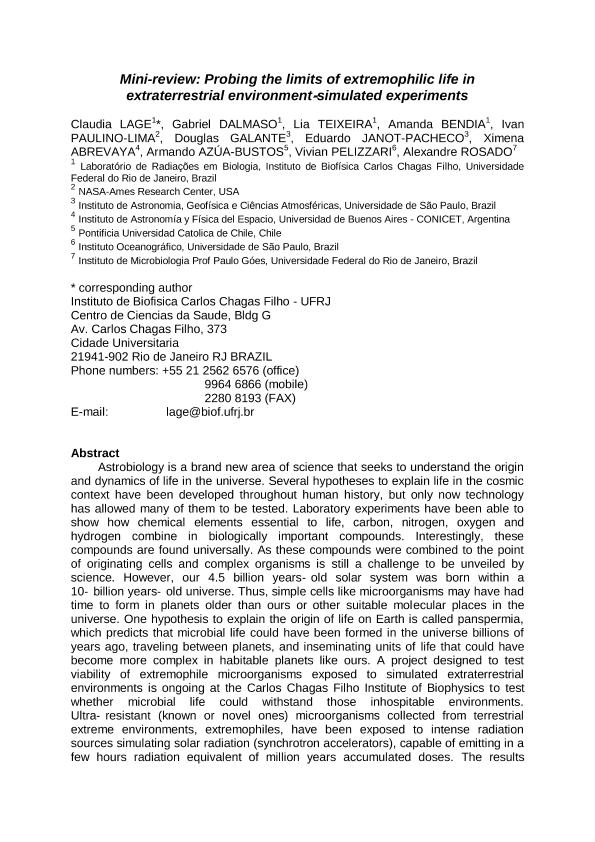Mostrar el registro sencillo del ítem
dc.contributor.author
Lage, Claudia
dc.contributor.author
Dalmaso, Gabriel
dc.contributor.author
Texeira, Lia
dc.contributor.author
Bendia, Amanda
dc.contributor.author
Paulino Lima, Ivan
dc.contributor.author
Galante, Douglas
dc.contributor.author
Janot Pacheco, Eduardo
dc.contributor.author
Abrevaya, Ximena Celeste

dc.contributor.author
Azúa Bustos, Armando
dc.contributor.author
Pellizzari, Vivian
dc.contributor.author
Rosado, Alexandre
dc.date.available
2017-07-04T19:49:06Z
dc.date.issued
2012-08
dc.identifier.citation
Lage, Claudia; Dalmaso, Gabriel; Texeira, Lia; Bendia, Amanda; Paulino Lima, Ivan; et al.; Probing the limits of extremophilic life in extraterrestrial environment-simulated experiments; Cambridge University Press; International Journal Of Astrobiology; 11; 4; 8-2012; 1-11
dc.identifier.issn
1473-5504
dc.identifier.uri
http://hdl.handle.net/11336/19512
dc.description.abstract
Astrobiology is a relatively recent scientific field that seeks to understand the origin and dynamics of life in the Universe. Several hypotheses have been proposed to explain life in the cosmic context throughout human history, but only now, technology has allowed many of them to be tested. Laboratory experiments have been able to show how chemical elements essential to life, such as carbon, nitrogen, oxygen and hydrogen combine in biologically important compounds. Interestingly, these compounds are ubiquitous. How these compounds were combined to the point of originating cells and complex organisms is still to be unveiled by science. However, our 4.5 billion years old Solar system appeared in a 10 billion years old Universe. Thus, simple cells such as micro-organisms may have had time to form in planets older than ours or in other suitable places in the universe. One hypothesis related to the appearance of life on Earth is called panspermia, which predicts that microbial life could have been formed in the Universe billions of years ago, travelling between planets, and inseminating units of life that could have become more complex in habitable planets such as Earth. A project designed to test the viability of extremophile micro-organisms exposed to simulated extraterrestrial environments is in progress at the Carlos Chagas Filho Institute of Biophysics (UFRJ, Brazil) to test whether microbial life could withstand inhospitable environments. Radiation-resistant (known or novel ones) micro-organisms collected from extreme terrestrial environments have been exposed (at synchrotron accelerators) to intense radiation sources simulating Solar radiation, capable of emitting radiation in a few hours equivalent to many years of accumulated doses. The results obtained in these experiments reveal an interesting possibility of the existence of microbial life beyond Earth.
dc.format
application/pdf
dc.language.iso
eng
dc.publisher
Cambridge University Press

dc.rights
info:eu-repo/semantics/openAccess
dc.rights.uri
https://creativecommons.org/licenses/by-nc-sa/2.5/ar/
dc.subject
Panspermia
dc.subject
Extremophiles
dc.subject
Uv
dc.subject
Cosmic Dust
dc.subject.classification
Biología Celular, Microbiología

dc.subject.classification
Ciencias Biológicas

dc.subject.classification
CIENCIAS NATURALES Y EXACTAS

dc.title
Probing the limits of extremophilic life in extraterrestrial environment-simulated experiments
dc.type
info:eu-repo/semantics/article
dc.type
info:ar-repo/semantics/artículo
dc.type
info:eu-repo/semantics/publishedVersion
dc.date.updated
2017-07-04T14:08:37Z
dc.journal.volume
11
dc.journal.number
4
dc.journal.pagination
1-11
dc.journal.pais
Reino Unido

dc.journal.ciudad
Cambridge
dc.description.fil
Fil: Lage, Claudia. Universidade Federal do Rio de Janeiro; Brasil
dc.description.fil
Fil: Dalmaso, Gabriel. Universidade Federal do Rio de Janeiro; Brasil
dc.description.fil
Fil: Texeira, Lia. Universidade Federal do Rio de Janeiro; Brasil
dc.description.fil
Fil: Bendia, Amanda. Universidade Federal do Rio de Janeiro; Brasil
dc.description.fil
Fil: Paulino Lima, Ivan. National Aeronautics And Space Administration; Estados Unidos
dc.description.fil
Fil: Galante, Douglas. Universidade do Sao Paulo. Instituto Astronomia, Geofisica e Ciencias Atmosfericas; Brasil
dc.description.fil
Fil: Janot Pacheco, Eduardo. Universidade do Sao Paulo. Instituto Astronomia, Geofisica e Ciencias Atmosfericas; Brasil
dc.description.fil
Fil: Abrevaya, Ximena Celeste. Consejo Nacional de Investigaciónes Científicas y Técnicas. Oficina de Coordinación Administrativa Ciudad Universitaria. Instituto de Astronomía y Física del Espacio. - Universidad de Buenos Aires. Facultad de Ciencias Exactas y Naturales. Instituto de Astronomía y Física del Espacio; Argentina
dc.description.fil
Fil: Azúa Bustos, Armando. Pontificia Universidad Católica de Chile; Chile
dc.description.fil
Fil: Pellizzari, Vivian. Universidade de Sao Paulo; Brasil
dc.description.fil
Fil: Rosado, Alexandre. Universidade Federal do Rio de Janeiro; Brasil
dc.journal.title
International Journal Of Astrobiology

dc.relation.alternativeid
info:eu-repo/semantics/altIdentifier/url/https://www.cambridge.org/core/journals/international-journal-of-astrobiology/article/minireview-probing-the-limits-of-extremophilic-life-in-extraterrestrial-environmentsimulated-experiments/0D5470821055110450CB64AD2A3CCBB2
dc.relation.alternativeid
info:eu-repo/semantics/altIdentifier/doi/http://dx.doi.org/10.1017/S1473550412000316
Archivos asociados
